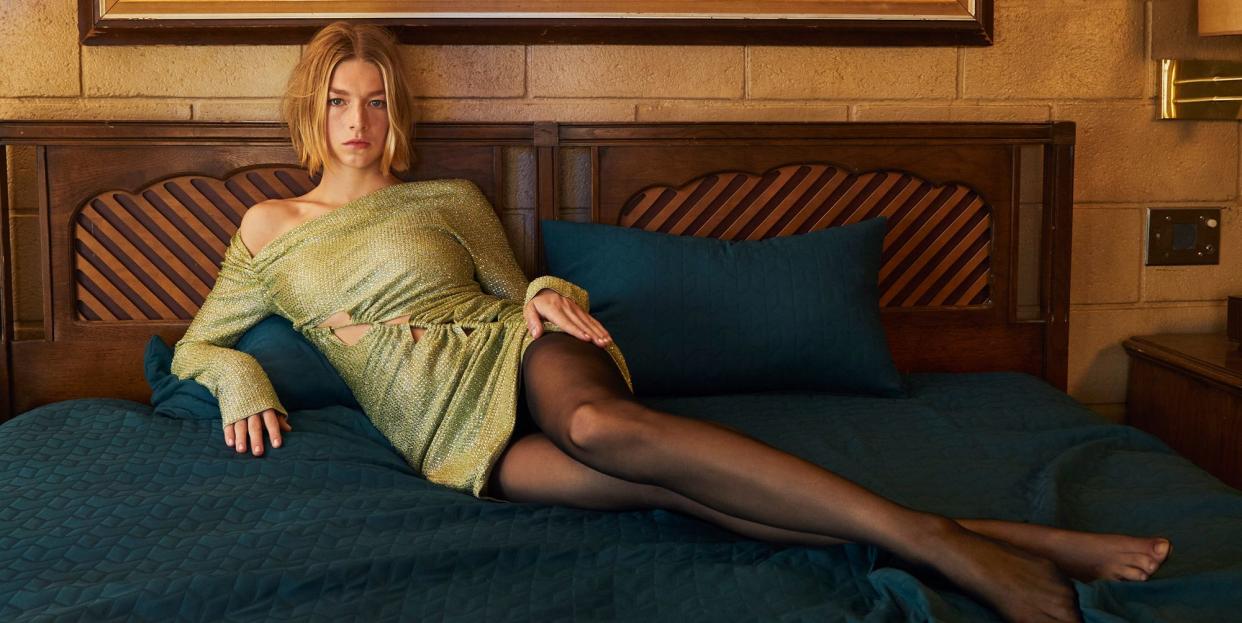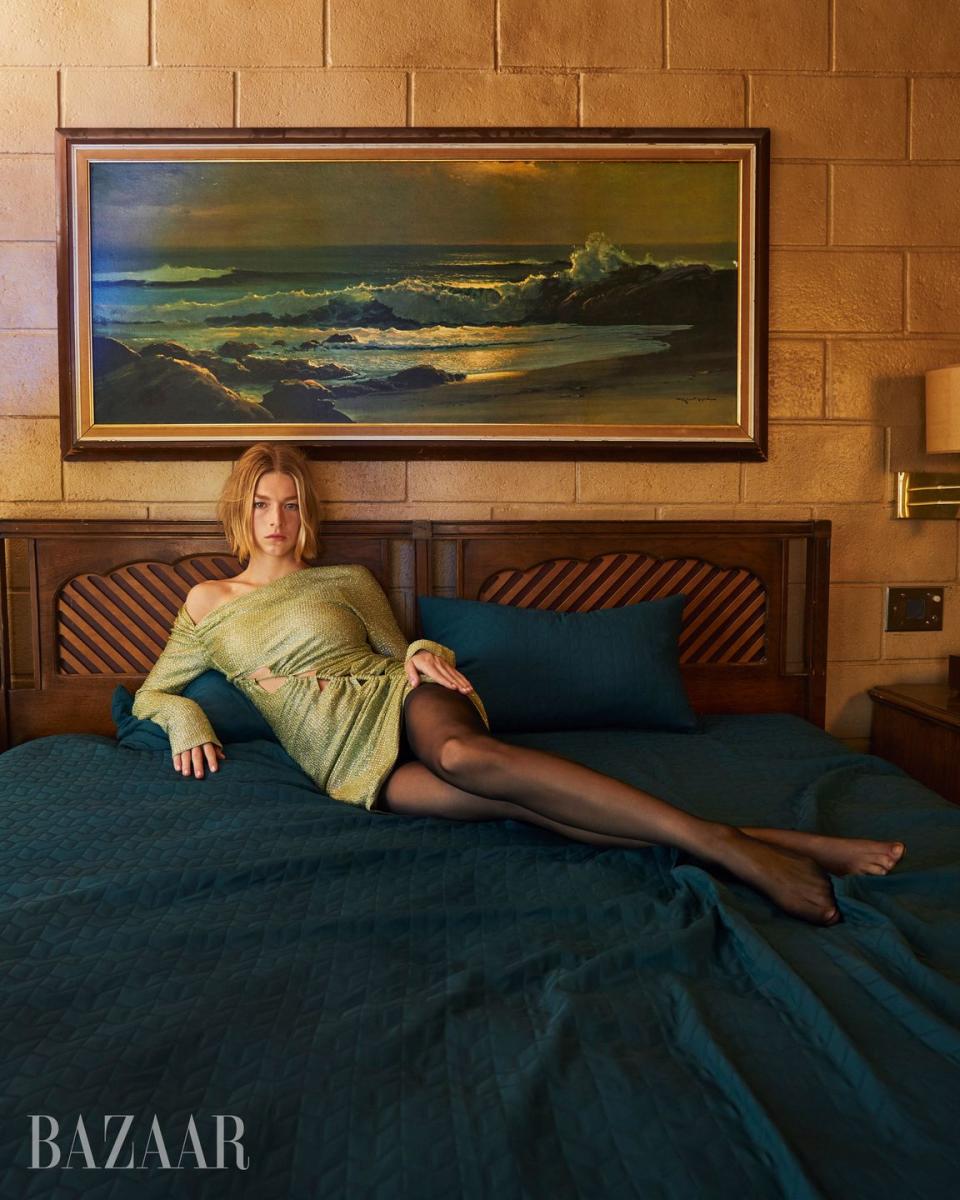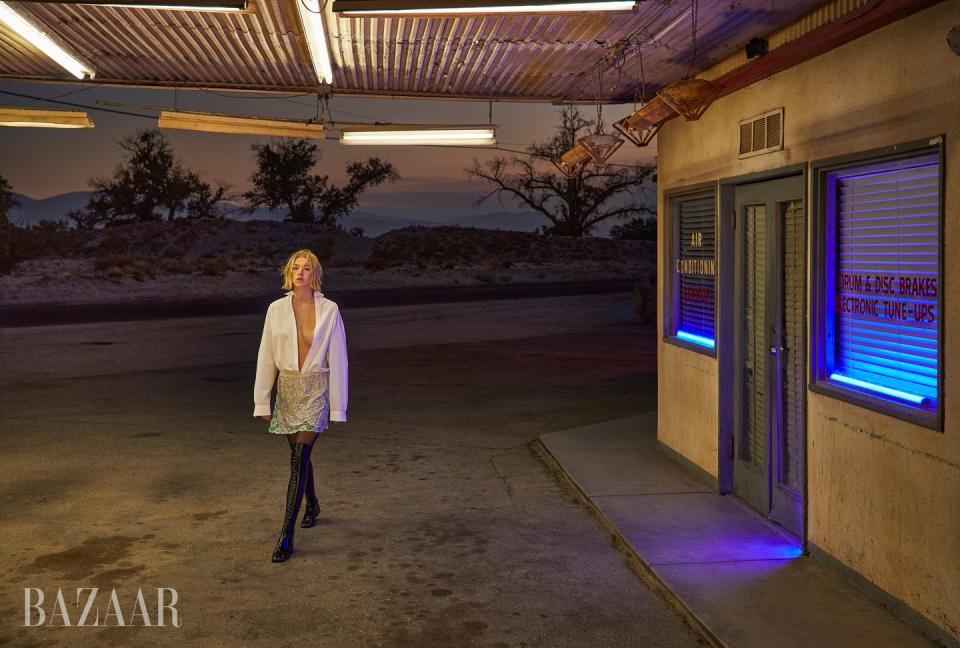Hunter Schafer Steps Into the Light

- Oops!Something went wrong.Please try again later.
- Oops!Something went wrong.Please try again later.
"Hearst Magazines and Yahoo may earn commission or revenue on some items through the links below."
It is a sunny morning in October, and Hunter Schafer is sitting on the floor of her Hollywood apartment opening a cardboard storage box that contains a lifetime of journals. “Somehow, pen and paper end up in my vicinity,” the 22-year-old actress, artist, model, producer, and writer tells me as she sorts through the bound notebooks, their pages thick with collages from fashion- magazine cutouts. She currently rents an apartment close to the set of Euphoria, the hit HBO teen drama in which she stars as Jules Vaughn, a new girl in town and the romantic heroine in the love story central to the ensemble cast. It’s the start of Schafer’s day off, and so far she has slept late to rest from shooting the show, which returns for a second season early this winter. She just got off the phone with her second-youngest sibling to wish her a happy birthday. (Schafer, the oldest of four, pauses when neither of us can remember what astrological season we’re in so that she can look it up. “Libra,” she says, with the relief of a big sister covering her bases.) She has put on the gray AndAfterThat hoodie she took from the floor of her costar Zendaya’s car (Schafer calls her “Z”) and wrapped her white-blond hair up in a high bun, and she is ready to show me the story of her life.

Schafer is in the process of digitally archiving this collection. “It’s a little scary, just having it in a cardboard box,” she says. It’s also, she continues, a little mind-blowing to have accumulated an approximate autobiography. “I have tons of journals about falling in love for the first time. I have all my thoughts about first transitioning. The day I first started hormone therapy.” Her hands go on either side of the book, flattening the journal’s spine, to show her class photo from 2013, perhaps 2014, before all those firsts. “Mostly everything before I transitioned is a blur. But as soon as I started working and had a bare purpose, it’s easier to refer to parts of my life: when I was a contributor for Rookie”—Tavi Gevinson’s beloved online teen magazine—“when my first modeling agency took me out to New York, when Euphoria happened. Now I’m in this new phase where I’m kind of comfortable. Life isn’t happening to me, for the first time.” But even before HBO came calling and made her an overnight star, Schafer was already showing signs of a kind of preternatural sensitivity and creative purpose.
While in high school at the prestigious University of North Carolina School of the Arts, Schafer was recognized for her visual art as a U.S. Presidential Scholar semifinalist; she published her illustrations, comics, and writing in Rookie; and she had plans to study fashion design at Central Saint Martins in London. In 2017 she moved to New York to instead pursue modeling, another avenue in which to explore her love of fashion, going on to walk the runways for Rick Owens, Dior, and Miu Miu. And in the midst of all this, she was the youngest plaintiff in the American Civil Liberties Union and Lambda Legal’s lawsuit challenging North Carolina’s House Bill 2, known as the “bathroom bill,” which required people to use public restrooms in accordance with the sex they were assigned at birth. She joined the suit, she wrote in Teen Vogue, to “represent other transgender youth in North Carolina who are as hurt as I am, and to raise awareness and acceptance for transgender individuals.”
It’s a lot of life to have packed into 22 years. As Schafer sets about preserving her past, what course will she chart for her future?

When the first episode of Euphoria aired in June 2019, more than one million people tuned in to see Schafer ride a blue bicycle across their screens. Since then, the show—created, directed, and written by Sam Levinson—has become a hit; beloved by fans and condemned by the Parents Television and Media Council, it is the story of Rue Bennett (played by Zendaya), an omnipresent narrator who tells us what’s happening to everyone else while the audience watches her story. Recently out of rehab and struggling with her own addictions, Rue has an infatuation with Schafer’s Jules that becomes more than romance; the stakes she puts on their love fall just short of redemption.
Schafer’s performance recalls Claire Danes as Angela Chase in My So-Called Life; the emotional arc of season one rose and fell with the tremble in her lower lip. But My So-Called Life preferred gentle realism as a lens for televised reality. Euphoria is a harsh high. A hyperstylized and formally beautiful production, the show is edited like a music video and plays like melodrama. Sequences of bad behavior and worse consequences build to unbearable levels of danger, and yet everyone still has to show up for school in the morning. So it does feel, at least, a little like being a teenager.
For Schafer, much of the work of becoming Jules has involved learning to be an actress. The onset of the pandemic derailed the initial shooting schedule planned for Euphoria’s highly anticipated second season. Levinson instead created a pair of special episodes to help bridge the gap until production could resume, with one focused entirely on Jules. “There’s a lot of me in Jules,” says Schafer, who was also credited as the cowriter and a producer on her special. “I do think blurred lines between an actor and a character make a deeper character.
“The work of an actor is trying to simulate a full life,” Schafer continues. “Some people might say that doesn’t make me as strong of an actor, but … that’s how I learned. I’m still forming that process and also setting boundaries, which I didn’t have in season one.” Over the phone, Zendaya, who has been acting in TV and movies for more than a decade, notes that she’s been able to witness Schafer’s swift evolution as an actress. “I remember watching behind the camera and knowing that something had clicked,” she says of Schafer’s special. “She just took whatever pain she had, and she translated it into such a beautiful performance.”

Schafer is slightly skeptical of Method acting, respecting the practice as a tradition but unsure if such a creative decision would be sustainable for her. “I’ve already spent a lot of my life trying to be someone I’m not,” she explains. “And even if it is my job title, I’m not interested in doing that again for long periods of time.” Instead of living as her characters, she is trying to stay attuned to how they can change or impact the way she lives as herself. “For the first 20 years of my life,” she says, “there were times I got so angry, to the point I could feel it in my body. Just in the past couple of years, I finally started being able to access that feeling and use that emotion to communicate why I’m angry.”
Schafer tells me she was not in therapy when she started on Euphoria—“Probably not a great idea,” she says, laughing—but she is now, and on set she’ll use a visualization process her current therapist suggested: In her mind, she’ll picture a box that contains everything about Jules, and at the end of the day she’ll picture shutting that box. “While I’m not entirely sure how well it works, I do like the ritual of it, just as far as creating a visual boundary.”
In the short time Schafer has been a public figure, she has been open about her struggles with her own emotions, both in the moment of experiencing them and in the way she processes them. In the early months of the pandemic, she considered checking into a mental-health facility, something she talked about during an appearance on Jimmy Fallon, “and now it’s the first thing that comes up when you search my name on YouTube: Hunter Schafer writes Euphoria episode instead of going to mental hospital.” This might be reductive, but it speaks to some truth; making art cannot replace therapy, but it can be therapeutic. During shooting, she recalls being in “actor mode, producer mode, writer mode all at the same time. I would be crying on set for eight hours and then be able to objectively look at the dailies, like, ‘Yeah, this is the right shot.’ ”
There’s a room in Schafer’s apartment that functions as her studio; an easel stands in one corner, and there’s a sewing table for making clothes and a bookshelf of supplies and reference texts. She has always made mood boards for every project, and there are several mood boards for the look she wore to this year’s Met Gala, including one McQueen image of a woman with eerie milky contacts, similar to the pure whites Schafer ended up wearing to accompany her custom Prada two-piece set and Evangeline AdaLioryn jewelry.

Schafer says her favorite way to get to know people is by making things together, and she’s become very close to her costars from Euphoria. “Knowing that she was so young and so much of this was new to her,” Zendaya tells me about when they first met, “my thing was being as much of a big sister as I could.” Though she is the youngest of six siblings in her own family, Zendaya feels that familial sense of care for Schafer. After all, no one needs a big sister like a big sister. While shooting difficult scenes, they spend time on set checking in with each other and making sure the intense contrasts of tone that Euphoria often demands aren’t becoming too overwhelming. “What we do for a living is important,” she says, “but the friendship we share is more important.” Calling from set, Heidi Bivens, the costume designer for the show as well as films such as Spring Breakers and Mid90s, describes Schafer’s professionalism as “unparalleled.” “She’s here to do the job with a sort of selflessness that helps her get into the character.” She flips through the rack of clothes she keeps for Schafer: Eckhaus Latta, Collina Strada, Maroske Peech, Hyein Seo, and Gogo Graham are a few favorites—labels that, if they share one common thread, are precise in their use of exposed seams and artfully unraveling hems. “Everyone’s excited to dress her,” Bivens tells me. “No one says no when we ask for fittings.”
The second time Schafer and I speak, it is on another Friday afternoon off. On her lap is a friend’s black French bulldog, and she is taking care of him as much as he’s taking care of her. She sometimes offers to pet-sit during weeks when she’s shooting especially sad scenes.
“One day,” she begins, “Z was telling a story from her childhood, and then she said, ‘You never talk about your childhood.’ It’s a little bit sad but also true to say that I feel like the story of my life begins in my late teens, when I was finally living in the world the way I was supposed to. I don’t know if I’ve talked about this in the press before, but I think there’s a phenomenon among the trans and queer community, and it’s why we make great artists a lot of the time. When your exterior world and your body and your self are not in line with who you are, you turn inward. And my theory is that I built a really rich inner world until I started feeling like myself in my body. I’ve been trying to do the work of digging up stuff, but it’s going to take a while to excavate everything.” What’s your mother like? I ask.
Proenza Schouler coat; Courrèges boots
“She’s amazing,” Schafer says. “She’s one of the people I feel closest to in the world. And…” Then she turns, holding the muscles in her profile still as she looks away, hand on her mouth. “No, it’s all good,” she recovers. “I cry every time I talk about my mother. She’s just really powerful.” Schafer calls for the puppy. “As I’ve gotten back into therapy and had time to chill, I’m less …” She pauses and starts again. “Even before I graduated high school, I’ve just been grinding, grinding, grinding to make a life for myself so that I can do what I want to do, and now I finally have space to reflect.”
In August 2021, Schafer’s first film project was announced: a horror movie, Cuckoo, directed by Tilman Singer and costarring John Malkovich and Gemma Chan, that is set to start production in 2022. She shows me some of the props she’s been sent so she can start preparing for that role: a large bass guitar to play and a small, dull knife to twirl.
Other projects are still secret, for reasons of love or nondisclosure agreements. Schafer is about to direct her first music video, though she can’t divulge any details; she is close to wrapping up the second season of Euphoria and can reveal only that it will be “a bit darker,” which is saying a lot with very few words. One day she hopes to work with people like Luca Guadagnino and Michaela Coel—writers, directors, and artists known for their vivid depictions of tangled emotions. “I want to have longevity as an artist, whatever form that comes in. The one thing I have faith in is the evolution of how I make art. It’s something that is growing in me all the time. But there’s no plan,” she says. “I’m not attached to one career. I want to do everything. I’m really lucky that I have space and resources to just … try new shit and see if it sticks.”

In discussing the story of Schafer’s life, I ask her who she imagines as her reader. Who would she give all these materials to when the time comes to tell her own story? She thinks about it for a moment. “Maybe, if I were to have kids, my daughter … or son. I said daughter automatically,” she says, “but if my mother had a book or some sort of archive of her life, I would read the shit out of that. I think trying to understand your parents is a weird part of growing up too, and there’s no guidebook for that.
“I haven’t spent more than three or four years in the same city, except for Raleigh when I was growing up,” Schafer reflects. “But since then it’s been these little pockets of special, intense relationships. Parents and siblings, my first friends in New York, my first love. And now my Euphoria family, the community I’ve found in Los Angeles. Not to say I’ve left the previous relationships behind, but I believe in ebbing and flowing. People need each other in a really special way sometimes, and then that need falls away as you both move forward in life. What’s left is the love and the care that carries on.”
Hair: Evanie Frausto; Makeup: Frankie Boyd for Shiseido; Manicure: Shigeko Taylor; Production: Alicia Zumback at Camp Productions; Set Design: Robert Doran.
This article originally appeared in the December 2021/January 2022 issue of Harper's BAZAAR, available on newsstands December 7.
GET THE LATEST ISSUE OF BAZAAR
You Might Also Like

